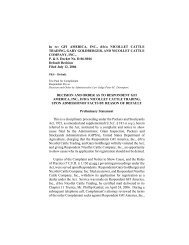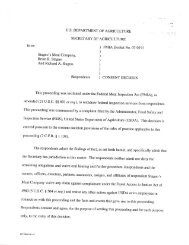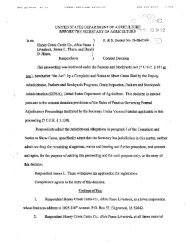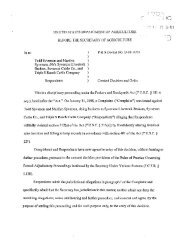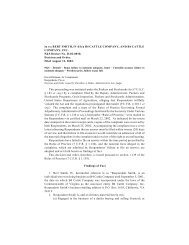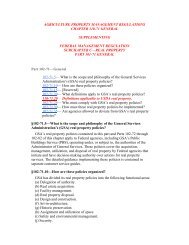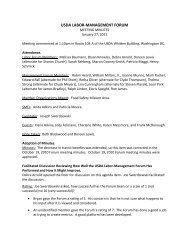1 UNITED STATES DEPARTMENT OF AGRICULTURE BEFORE ...
1 UNITED STATES DEPARTMENT OF AGRICULTURE BEFORE ...
1 UNITED STATES DEPARTMENT OF AGRICULTURE BEFORE ...
Create successful ePaper yourself
Turn your PDF publications into a flip-book with our unique Google optimized e-Paper software.
care and feeding of lions, tigers and other big cats, accompanied an inspector and visited<br />
the Kaufman facility where she found tiger cubs with misshapen rear legs indicative of<br />
metabolic bone disease caused by a poor diet having been fed either to them or the cubs’<br />
mother. On the basis of the types of food found at the facility and admissions by Mr.<br />
Cook and an attendant at the facility, the veterinarian concluded that Respondents were<br />
not following the prescribed dietary recommendations of the attending veterinarian they<br />
employed. (Cx 29, p1, Cx 30, p 2, Cx 31, p 2, Cx 36 pp 1-9, Tr 84-126).<br />
d) On June 12, 2003, contrary to veterinarian care standards set forth in 7<br />
C.F.R. § 2.40, two tiger cubs suffering from alopecia (hair loss) were not being treated<br />
for this condition and were not taken to the attending veterinarian for diagnosis and<br />
treatment; instead, Marcus Cook was erroneously treating them with a medication for<br />
ringworm based on his own incorrect, uninformed diagnosis. On August 27, 2004, an<br />
APHIS inspector determined that a veterinarian had last visited Respondents’ Kaufman<br />
facility on June 30, 2003, contrary to this standard’s requirement for annual veterinarian<br />
visits. Moreover, at the time of the August 27, 2004 inspection, two of the youngest tigers<br />
and the smallest lion displayed protruding hip bones, dull coats of hair and less vigor than<br />
other animals at the facility. Respondents had not undertaken to have the cause of their<br />
condition evaluated by a veterinarian as instructed by APHIS inspectors at a prior<br />
inspection when these problems were first observed. On February 9, 2006 Respondents<br />
had not obtained veterinary care for a tiger that had re-injured a leg a couple of days<br />
earlier. (Rx 6, p 35). On February 23, 2007, a tiger requiring veterinarian evaluation due<br />
to its excessive hair loss and weight loss was observed by an APHIS inspector who<br />
8




